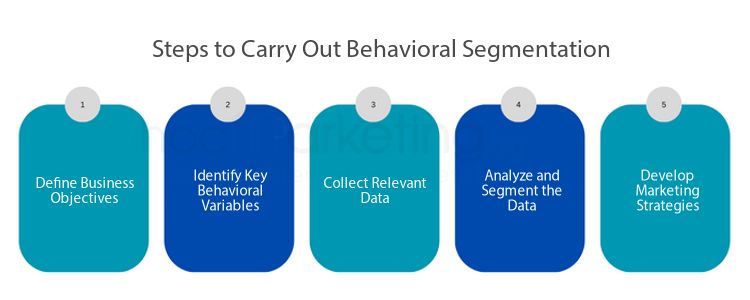
What is Behavioral Segmentation? Advantages & Disadvantages? Steps to carry out

Discover the advantages and disadvantages of behavioral segmentation and learn how to carry it out in 5 easy steps. Get inspired by successful examples from Amazon, Netflix, and Spotify. Improve your marketing ROI and customer experience with this effective strategy.
1. What is Behavioral Segmentation?
Behavioral Segmentation is a marketing strategy that involves dividing a target audience into groups based on their behavior patterns, such as buying habits, product usage, and response to marketing campaigns. By segmenting consumers according to their behavior, businesses can tailor their marketing messages and offerings to better suit their customers' needs, preferences, and interests. This approach allows businesses to create more targeted and effective marketing campaigns, resulting in increased sales and revenue, improved customer experience, and better understanding of their customers. In the following sections, we will delve into the advantages and disadvantages of behavioral segmentation, as well as the steps businesses can take to carry out this segmentation strategy successfully.2. Advantages of Behavioral Segmentation
Behavioral segmentation is a marketing strategy that involves dividing a customer base into groups based on their behaviors, actions, and preferences. This type of segmentation is advantageous for businesses as it allows them to create targeted marketing campaigns, improve customer engagement, and increase sales and revenue. In this section, we will explore the advantages of behavioral segmentation.Firstly, one of the primary advantages of behavioral segmentation is increased sales and revenue. By understanding customer behavior, businesses can create targeted marketing campaigns that resonate with their audience, resulting in increased sales. For example, a business can segment customers based on their purchasing behavior and create personalized offers or promotions that encourage them to make a purchase.
Secondly, behavioral segmentation can lead to improved customer experience. By understanding customer behavior, businesses can tailor their products and services to meet customer needs and preferences. This leads to a better customer experience, which in turn leads to increased customer loyalty and retention.
Thirdly, behavioral segmentation can improve marketing return on investment (ROI). By targeting specific customer groups, businesses can create more effective marketing campaigns that generate higher returns. This is because the marketing message is tailored to the needs and preferences of the target audience, resulting in a higher response rate.
Lastly, behavioral segmentation allows businesses to gain a better understanding of their customers. By analyzing customer behavior, businesses can identify patterns and trends in customer preferences, which can inform future marketing strategies and product development. This leads to a more customer-focused approach, which can help businesses stay ahead of their competitors.
Increased Sales and Revenue
Behavioral segmentation is a powerful marketing strategy that has been gaining popularity among businesses in recent years. One of the main advantages of behavioral segmentation is the potential to increase sales and revenue. By analyzing customer behavior, businesses can identify patterns and preferences, and tailor their marketing efforts to meet the specific needs of their target audience. This can lead to more effective communication, higher engagement, and ultimately, increased sales.Behavioral segmentation allows businesses to identify customers who are most likely to make a purchase, and target them with personalized marketing messages. For example, a company may use data on a customer's past purchases to offer them relevant products or promotions. By delivering targeted messages to customers who are already interested in a product or service, businesses can increase the likelihood of a sale and boost revenue.
Another way behavioral segmentation can lead to increased sales is by improving customer loyalty. By understanding what motivates customers to make a purchase, businesses can create better experiences and build stronger relationships with their customers. This can lead to repeat business and positive word-of-mouth, which can ultimately drive sales and revenue.
In summary, behavioral segmentation can be a powerful tool for businesses looking to increase sales and revenue. By analyzing customer behavior and tailoring marketing efforts to meet their specific needs, businesses can improve engagement, build loyalty, and ultimately drive more sales.
Improved Customer Experience
Behavioral Segmentation allows businesses to understand their customers' behaviors and preferences, enabling them to tailor their marketing efforts accordingly. One of the significant advantages of Behavioral Segmentation is that it can lead to improved customer experience. By understanding customers' behaviors and preferences, businesses can create targeted campaigns that cater to their specific needs and interests. This approach can help build customer loyalty and enhance their overall experience with the brand. By analyzing customer behaviors such as purchasing habits, browsing history, and search queries, businesses can personalize their marketing efforts and make their customers feel valued. This, in turn, can lead to increased customer satisfaction and retention.Improved Marketing ROI
Behavioral segmentation can lead to improved marketing ROI, which is a key advantage for businesses. By targeting customers based on their behavior, companies can create more effective and efficient marketing campaigns. This is because they are able to tailor their messaging and offers to specific customer needs and preferences, increasing the likelihood of engagement and conversion. Additionally, behavioral segmentation can help companies identify patterns in customer behavior, which can inform future marketing decisions and strategies. Overall, improved marketing ROI is a significant benefit of implementing behavioral segmentation in a business.Better Understanding of Customers
Behavioral segmentation provides businesses with a better understanding of their customers, allowing them to tailor their marketing strategies and improve customer experience. By analyzing customer behavior, businesses can identify patterns and preferences that can inform their marketing strategies, product development, and customer service. This understanding can lead to increased customer loyalty and retention, as well as improved acquisition efforts. In the following sub-sections, we will explore the ways in which behavioral segmentation can provide a better understanding of customers and how businesses can use this information to their advantage.3. Disadvantages of Behavioral Segmentation
Behavioral segmentation is an effective marketing strategy that enables businesses to target specific groups of customers based on their behaviors. However, this type of segmentation also has some disadvantages that businesses should consider before implementing it. In this section, we will discuss the potential drawbacks of behavioral segmentation.Firstly, one of the main disadvantages of behavioral segmentation is its limited scope. This means that businesses may miss out on potential customers who exhibit different behaviors or fall outside the parameters of the segmentation. For example, if a business segments its customers based on their purchase history, it may overlook potential customers who have not made a purchase yet.
Secondly, data privacy concerns can arise when implementing behavioral segmentation. Collecting and analyzing personal data about customers can raise ethical concerns, and there is also a risk of data breaches or misuse. Businesses must ensure that they are following ethical and legal guidelines when collecting and using customer data.
Thirdly, implementing behavioral segmentation can be costly for businesses. It requires significant investments in data collection, analysis, and marketing strategies. Small businesses may find it difficult to allocate the necessary resources to carry out behavioral segmentation effectively.
Lastly, overreliance on segmentation can also be a disadvantage of behavioral segmentation. If businesses rely too heavily on segmentation, they may overlook other important factors that impact customer behavior. For example, a business may segment its customers based on their age, but fail to consider other factors such as cultural background or personal values.
In conclusion, while behavioral segmentation has many benefits, it also has some disadvantages that businesses must consider before implementing it. These include limited scope, data privacy concerns, costly implementation, and overreliance on segmentation. Businesses should carefully weigh the pros and cons of behavioral segmentation before deciding whether to implement it as part of their marketing strategy.
Limited Scope
Behavioral segmentation, while advantageous in many ways, also has its limitations. One limitation is its scope. Behavioral segmentation focuses solely on customer behavior and may miss other important factors that influence customer decisions, such as demographics or psychographics. For example, a customer may purchase a product due to a promotional offer rather than their usual behavior. This purchase may not accurately reflect their true behavior and may result in incorrect segmentation. As a result, businesses should consider combining behavioral segmentation with other segmentation techniques to gain a more comprehensive understanding of their customers.Data Privacy Concerns
Behavioral segmentation requires collecting and analyzing customer data to identify patterns and behaviors. However, this process raises concerns about data privacy. Customers may feel uncomfortable with companies collecting and using their personal information for marketing purposes. Therefore, it is essential for companies to be transparent about their data collection practices and provide customers with opt-in options. Moreover, companies must comply with data protection laws and regulations to avoid legal and reputational risks. Failure to do so can result in loss of customer trust, negative publicity, and legal penalties. Thus, companies must balance the benefits of behavioral segmentation with the privacy concerns of their customers.Costly Implementation
One of the potential drawbacks of implementing behavioral segmentation is the cost involved. Collecting and analyzing customer data can be an expensive process, especially for smaller businesses without the resources to invest in sophisticated analytics tools or hire data analysts. Additionally, there may be ongoing costs associated with maintaining and updating the behavioral segmentation model as customer behavior changes over time. Despite these challenges, many businesses find that the benefits of behavioral segmentation outweigh the costs, and that the insights gained through this approach ultimately lead to increased profits and improved customer satisfaction.Overreliance on Segmentation
Overreliance on Segmentation can be a potential disadvantage of behavioral segmentation. Although it helps in understanding the customers and their buying patterns, relying too much on segmentation can result in overlooking other important factors that could impact customer behavior. Businesses may end up ignoring individual customer needs and preferences, and instead, focus solely on the characteristics of the segment they belong to. This can lead to a lack of personalized marketing strategies and ultimately, a decrease in customer satisfaction.Additionally, overreliance on segmentation can result in a failure to adapt to changing customer behaviors. Customer preferences and behaviors are subject to change, and businesses need to continuously monitor and analyze the data to keep up with these changes. Overreliance on segmentation can lead to a lack of flexibility in marketing strategies, which can result in missed opportunities to attract new customers or retain existing ones.
Therefore, while behavioral segmentation is an effective marketing strategy, businesses should be cautious not to solely rely on it. They should instead focus on a holistic approach that combines customer behavior, demographics, and psychographics, among other factors, to develop personalized marketing strategies that cater to individual customer needs and preferences.
4. Steps to Carry Out Behavioral Segmentation
To carry out behavioral segmentation successfully, there are several steps that businesses need to follow. Firstly, they need to define their business objectives and identify the key behavioral variables that are relevant to their target audience. This involves understanding the different behaviors that customers exhibit, such as their purchase history, website browsing behavior, social media engagement, and other relevant factors.Once the key behavioral variables have been identified, the next step is to collect relevant data related to these variables. This can be done through customer surveys, focus groups, online analytics tools, and other data collection methods. The data collected must be accurate and relevant to the business objectives in order to ensure that the segmentation strategy is successful.
Once the data has been collected, it needs to be analyzed and segmented into different groups based on the behavioral variables identified earlier. This involves using statistical analysis tools and techniques to identify patterns and trends in the data. This step is critical to ensure that the segments are meaningful and useful for developing marketing strategies.
The next step is to develop marketing strategies that are tailored to the different segments identified through behavioral segmentation. This involves developing targeted messaging, offers, and promotions that are designed to appeal to the specific needs and preferences of each segment. These strategies must be developed with the business objectives in mind and should be tested and refined over time to ensure that they are effective.
Overall, behavioral segmentation can be a powerful tool for businesses looking to improve their marketing and customer experience strategies. By following these steps, businesses can develop effective segmentation strategies that enable them to better understand their customers, increase sales and revenue, and improve their marketing ROI.
Define Business Objectives
To effectively carry out behavioral segmentation, businesses first need to define their objectives. This involves identifying what they hope to achieve through the segmentation process, such as improving customer satisfaction, increasing sales, or enhancing marketing effectiveness. Clearly defined objectives are essential for selecting the appropriate behavioral variables to segment customers and developing targeted marketing strategies. Without a clear understanding of what they hope to achieve, businesses risk wasting time and resources on ineffective segmentation efforts, or missing opportunities to gain valuable insights into customer behavior. Therefore, defining business objectives is a crucial first step for successful behavioral segmentation.Identify Key Behavioral Variables
Identifying key behavioral variables is a crucial step in carrying out behavioral segmentation. Behavioral variables are the specific actions or behaviors exhibited by customers that can be used to group them into segments. These variables can include purchase history, frequency of purchases, brand loyalty, product usage, and customer satisfaction, among others.In order to identify the key behavioral variables, businesses must first define their business objectives and target audience. Once this is established, they can collect relevant data through market research, surveys, and customer feedback. This data can then be analyzed to identify common patterns and behaviors among customers.
It is important to note that the key behavioral variables may differ depending on the industry and specific business goals. For example, a retail company may focus on purchase history and frequency of purchases, while a software company may focus on product usage and customer satisfaction.
Overall, identifying the key behavioral variables is a crucial step in carrying out effective behavioral segmentation. By understanding the specific actions and behaviors exhibited by customers, businesses can create targeted marketing strategies that resonate with their audience and drive sales and revenue.
Collect Relevant Data
To effectively carry out behavioral segmentation, businesses must collect relevant data. The data collected should be relevant to the key behavioral variables identified earlier in the segmentation process. This data can be collected through various means such as surveys, customer feedback, website analytics, social media analytics, and purchase history.It is crucial to collect accurate data as it influences the effectiveness of the segmentation strategy. One way to ensure data accuracy is to use multiple sources of data and cross-check the information received. Data collection should also comply with data privacy regulations to avoid any legal issues.
Once the data is collected, it needs to be organized and analyzed to identify patterns and trends. The data should be segmented based on the identified behavioral variables, which will provide insights into the customer behavior and preferences. This analysis will enable businesses to create targeted marketing campaigns and personalized experiences for their customers.
Overall, collecting relevant data is a crucial step in the behavioral segmentation process. It provides businesses with insights into customer behavior, which can be used to develop effective marketing strategies.
Analyze and Segment the Data
After collecting relevant data, the next step in behavioral segmentation is to analyze and segment the data. This involves identifying patterns and trends in the data to create distinct groups or segments of customers based on their behaviors and preferences. The goal is to identify groups of customers who share similar needs, interests, and behaviors, and then develop targeted marketing strategies to meet their specific needs. This process usually involves statistical analysis of the data to identify the most significant variables and factors that influence customer behavior. Once the data has been analyzed and segmented, marketers can use this information to create more personalized marketing campaigns and messages that resonate with their target audience.Develop Marketing Strategies
After analyzing and segmenting the data, the next step in behavioral segmentation is to develop marketing strategies. This involves creating targeted campaigns and messages that appeal to specific behavioral segments. For example, if a customer has a history of purchasing high-end products, a marketing strategy could be to offer them exclusive discounts on luxury items. On the other hand, if a customer has a history of browsing but not purchasing, a marketing strategy could be to send them personalized recommendations or reminders about items in their cart.Marketing strategies should be tailored to the specific needs and behaviors of each segment. This means that different segments may require different communication channels, such as email, social media, or text messaging. The messaging should also be consistent with the brand's overall messaging and tone, while addressing the specific needs and preferences of each segment.
It is important to note that the success of behavioral segmentation relies on the accuracy and relevance of the data collected. Marketing strategies should be tested and refined over time to ensure that they are effective in driving sales and improving customer experience. Additionally, it is important to avoid overreliance on segmentation and to continue to gather feedback and insights from customers to ensure that marketing strategies remain relevant and effective.
5. Examples of Successful Behavioral Segmentation
Behavioral segmentation has become an essential tool for businesses to understand their customers better and tailor their marketing strategies accordingly. Many successful businesses have implemented behavioral segmentation and reaped the benefits. In this section, we will look at three examples of successful behavioral segmentation by Amazon, Netflix, and Spotify.Amazon, the e-commerce giant, has been using behavioral segmentation to personalize the shopping experience for its customers. It collects data on customers' browsing and purchase history, and uses it to recommend products based on their preferences. For instance, if a customer frequently buys books in the genre of science fiction, Amazon's algorithm will suggest new releases in that genre. This personalized approach has led to increased sales and improved customer experience.
Netflix, the streaming service provider, has been using behavioral segmentation to improve its content recommendations. It analyzes customers' viewing history, search queries, and ratings to suggest movies and TV shows that they are likely to enjoy. Netflix's algorithm is so accurate that it has led to 80% of the content watched on its platform being based on its recommendations. This has resulted in increased customer satisfaction and retention.
Spotify, the music streaming service provider, has been using behavioral segmentation to personalize its music recommendations. It collects data on customers' listening history, playlists, and searches to suggest songs and artists they are likely to enjoy. This personalized approach has led to increased user engagement and improved customer retention. Spotify has also been using behavioral segmentation to offer targeted advertising to its users, which has led to improved marketing ROI.
These examples show that behavioral segmentation can be a powerful tool for businesses to improve their marketing strategies, increase sales and revenue, and enhance customer experience. By collecting and analyzing relevant data, businesses can gain a better understanding of their customers' preferences and tailor their offerings accordingly.















